A Numerical Investigation to Determine the p–y Curves of Laterally Loaded Piles
Abstract
:1. Introduction
2. p–y Method and Code Development
2.1. p–y Method
2.2. Drucker–Prager Model
2.3. MATLAB Code
3. 2-D p–y Curve Modeling
3.1. Geometry, Mesh, and Boundary Conditions
3.2. Initial Stress State
3.3. Validation
4. Sensitivity Analysis
4.1. Number of Elements
4.2. Interface Thickness
5. Effect of Clay Fraction on p–y Curves
6. Conclusions
- The p–y results agree with the empirical results of Matlock. The validation reveals that the DP model leads to lower p–y curves with respect to those from Matlock and API when the horizontal displacement is less than 0.35B.
- The number of elements has no important effect on the p–y curves. Considering the necessary computational time, the p–y modeling with the MATLAB code is effective when 6000 ~ 10,000 elements are adopted for the spatial discretization.
- The p–y curves are independent of interface thicknesses from 5 mm to 10 cm.
- Clay content influences the p–y curve results. When y < 0.15B, the same lateral capacity values are resulted at clay contents of 27.5% and 55%, and they are higher than the curve of the sand. The normalized p–y curves show a decreasing trend with increasing clay content after y > 0.15B.
Author Contributions
Funding
Institutional Review Board Statement
Informed Consent Statement
Data Availability Statement
Acknowledgments
Conflicts of Interest
References
- Zhang, Y.; Andersen, K.H.; Jeanjean, P. Cyclic py curves in clays for offshore structures. In Proceedings of the Offshore Technology Conference, Houston, TX, USA, 6–9 May 2019. [Google Scholar]
- Wolf, T.K.; Rasmussen, K.L.; Hansen, M.; Ibsen, L.; Roesen, H. Assessment of Py Curves from Numerical Methods for a Non-Slender Monopile in Cohesionless Soil; Department of Civil Engineering, Aalborg University: Aalborg, Denmark, 2013. [Google Scholar]
- Dash, S.; Rouholamin, M.; Lombardi, D.; Bhattacharya, S. A practical method for construction of py curves for liquefiable soils. Soil Dyn. Earthq. Eng. 2017, 97, 478–481. [Google Scholar] [CrossRef]
- Liu, X.; Cai, G.; Liu, L.; Liu, S.; Duan, W.; Puppala, A.J. Improved py curve models for large diameter and super-long cast-in-place piles using piezocone penetration test data. Comput. Geotech. 2021, 130, 103911. [Google Scholar] [CrossRef]
- Yang, Z.; Jeremić, B. Numerical analysis of pile behaviour under lateral loads in layered elastic-plastic soils. Int. J. Numer. Anal. Methods Geomech. 2002, 26, 1385–1406. [Google Scholar] [CrossRef]
- Yang, Z.; Jeremić, B. Study of soil layering effects on lateral loading behavior of piles. J. Geotech. Geoenvironmental Eng. 2005, 131, 762–770. [Google Scholar] [CrossRef] [Green Version]
- Wang, S.-F.; Tang, Y.; Wang, S.-Y. Influence of brittleness and confining stress on rock cuttability based on rock indentation tests. J. Cent. South Univ. 2021, 28, 2786–2800. [Google Scholar] [CrossRef]
- Yu, Q.; Yin, K.; Ma, J.; Shimada, H. Vertical Shaft Support Improvement Studies by Strata Grouting at Aquifer Zone. Adv. Civ. Eng. 2018, 2018, 5365987. [Google Scholar] [CrossRef]
- Wang, J.; Yang, S.; Wei, W.; Zhang, J.; Song, Z. Drawing mechanisms for top coal in longwall top coal caving (LTCC): A review of two decades of literature. Int. J. Coal Sci. Technol. 2021, 1–26. [Google Scholar] [CrossRef]
- Mikkelsen, A.T.; Nielsen, S.D.; Østergaard, M.U. Finite Element Modelling of p-y curves for Monopiles in Liquefied Soil. In Proceedings of the 29th International Ocean and Polar Engineering Conference, Honolulu, HI, USA, 16–21 June 2019. [Google Scholar]
- Wang, S.-F.; Yu, T.; Li, X.-B.; Kun, D. Analyses and predictions of rock cuttabilities under different confining stresses and rock properties based on rock indentation tests by conical pick. Trans. Nonferrous Met. Soc. China 2021, 31, 31–1766. [Google Scholar] [CrossRef]
- Bonnet, M.; Frangi, A. Analyse des structures mécaniques par la méthode des éléments finis. Notes de Cours, Ecole Polytechnique. 2005. Available online: http://nguyen.hong.hai.free.fr/EBOOKS/SCIENCE%20AND%20ENGINEERING/MATHEMATIQUE/PROGRAMMING/FINITE%20ELEMENTS%20METHODE/Analyse%20m%E9canique%20par%20FEM.Bonnet.pdf (accessed on 23 May 2021).
- Bonnet, M.; Frangi, A.; Rey, C. The Finite Element Method in Solid Mechanics; McGraw Hill Education: New York, NY, USA, 2014; p. 365. [Google Scholar]
- Jeanjean, P.; Zhang, Y.; Zakeri, A.; Andersen, K.; Gilbert, R.; Senanayake, A. A framework for monotonic py curves in clays. In Proceedings of the Offshore Site Investigation Geotechnics 8th International Conference Proceeding, London, UK, 12–14 September 2017; pp. 108–141. [Google Scholar]
- Martin, C.; Randolph, M. Upper-bound analysis of lateral pile capacity in cohesive soil. Géotechnique 2006, 56, 141–145. [Google Scholar] [CrossRef]
- Matlock, H. Correlations for design of laterally loaded piles in soft clay. In Proceedings of the Offshore Technology in Civil Engineering’s Hall of Fame Papers from the Early Years, Houston, TX, USA, 1 April 1970; pp. 77–94. [Google Scholar]
- McClelland, B.; Focht, J. Soil modulus for laterally loaded piles. J. Soil Mech. Found. Div. 1956, 82, 1081-1. [Google Scholar] [CrossRef]
- Yang, M.; Ge, B.; Li, W.; Zhu, B. Dimension effect on py model used for design of laterally loaded piles. Procedia Eng. 2016, 143, 598–606. [Google Scholar] [CrossRef] [Green Version]
- Nogami, T.; Otani, J.; Konagai, K.; Chen, H.-L. Nonlinear soil-pile interaction model for dynamic lateral motion. J. Geotech. Eng. 1992, 118, 89–106. [Google Scholar] [CrossRef]
- Ahayan, S. A constitutive Model for natural Clays: From Laboratory Testing to Modelling of Offshore Monopiles; École centrale de Nantes, Université de Liège, Faculté des Sciences: Liège, Belgium, 2019. [Google Scholar]
- Sjrensen, S.P.H.; Brjdbцk, K.T.; Mjller, M.; Augustesen, A.H. Review of Laterally Loaded Mono-Piles Employed as the Foundation for Offshore Wind Turbines; Department of Civil Engineering, Aalborg University: Aalborg, Denmark, 2012. [Google Scholar]
- Ahayan, S.; Cerfontaine, B.; Collin, F.; Kotronis, P. Behaviour of laterally loaded pile. In Proceedings of the 9th European Conference on Numerical Methods in Geotechnical Engineering, NUMGE 2018, Porto, Portugal, 25–27 June 2018; pp. 1511–1518. [Google Scholar]
- Suryasentana, S.K.; Lehane, B.M. Numerical derivation of CPT-based p-y curves for piles in sand. Géotechnique 2014, 64, 186–194. [Google Scholar] [CrossRef]
- Zhang, Y.; Andersen, K.H. Scaling of lateral pile py response in clay from laboratory stress-strain curves. Mar. Struct. 2017, 53, 124–135. [Google Scholar] [CrossRef]
- API. American petroleum institute recommended practice for planning, designing and constructing fixed offshore platforms-working stress design. In API RP2A-WSD; American Petroleum Institute: Washington, DC, USA, 2007. [Google Scholar]
- Drucker, D.C.; Prager, W. Soil mechanics and plastic analysis or limit design. Q. Appl. Math. 1952, 10, 157–165. [Google Scholar] [CrossRef] [Green Version]
- Borja, R.I. Plasticity: Modeling & Computation; Springer Science & Business Media: Berlin/Heidelberg, Germany, 2013. [Google Scholar]
- Yin, K.; Liu, J.; Lin, J.; Vasilescu, A.-R.; Othmani, K.; Di Filippo, E. Interface Direct Shear Tests on JEZ-1 Mars Regolith Simulant. Appl. Sci. 2021, 11, 7052. [Google Scholar] [CrossRef]
- Vasilescu, A.-R. Design and Execution of Energy Piles: Validation by In-Situ and Laboratory Experiments. Ph.D. Theis, École Centrale de Nantes, Nantes, France, 2019. [Google Scholar]
- Dafalla, M.A. Effects of clay and moisture content on direct shear tests for clay-sand mixtures. Adv. Mater. Sci. Eng. 2013, 2013, 562726. [Google Scholar] [CrossRef] [Green Version]
- Maghsoodi, S. Thermo-Mechanical Behavior of Soil-Structure Interface under Monotonic and Cyclic Loads in the Context of Energy Geostructures. Ph.D. Theis, Université de Lorraine, Nancy, France, 2020. [Google Scholar]
- Maghsoodi, S.; Cuisinier, O.; Masrouri, F. Effect of Temperature on the Cyclic Behavior of Clay-Structure Interface. J. Geotech. Geoenvironmental Eng. 2020, 146, 04020103. [Google Scholar] [CrossRef]
- Konkol, J.; Mikina, K. Some Aspects of Shear Behavior of Soft Soil–Concrete Interfaces and Its Consequences in Pile Shaft Friction Modeling. Materials 2021, 14, 2578. [Google Scholar] [CrossRef] [PubMed]
- Yin, K.; Liu, J.; Vasilescu, A.-R.; Di Filippo, E.; Othmani, K. A Procedure to Prepare Sand–Clay Mixture Samples for Soil–Structure Interface Direct Shear Tests. Appl. Sci. 2021, 11, 5337. [Google Scholar] [CrossRef]
- Geuzaine, C.; Remacle, J.F. Gmsh: A 3-D finite element mesh generator with built-in pre-and post-processing facilities. Int. J. Numer. Methods Eng. 2009, 79, 1309–1331. [Google Scholar] [CrossRef]
- Østergaard, M.U.; Knudsen, B.S.; Ibsen, L.B. P-y curves for bucket foundations in sand using finite element modeling. In Proceedings of the 3rd Internationl symposium on Frontiers in offshore Geotechnics, Oslo, Norway, 10–12 June 2015; pp. 343–348. [Google Scholar]
- Vethanayagam, V.; Ibsen, L.B. Determination of py Curves for Bucket Foundations in Silt and Sand Using Finite Element Modelling; Department of Civil Engineering, Aalborg University: Aalborg, Denmark, 2017. [Google Scholar]
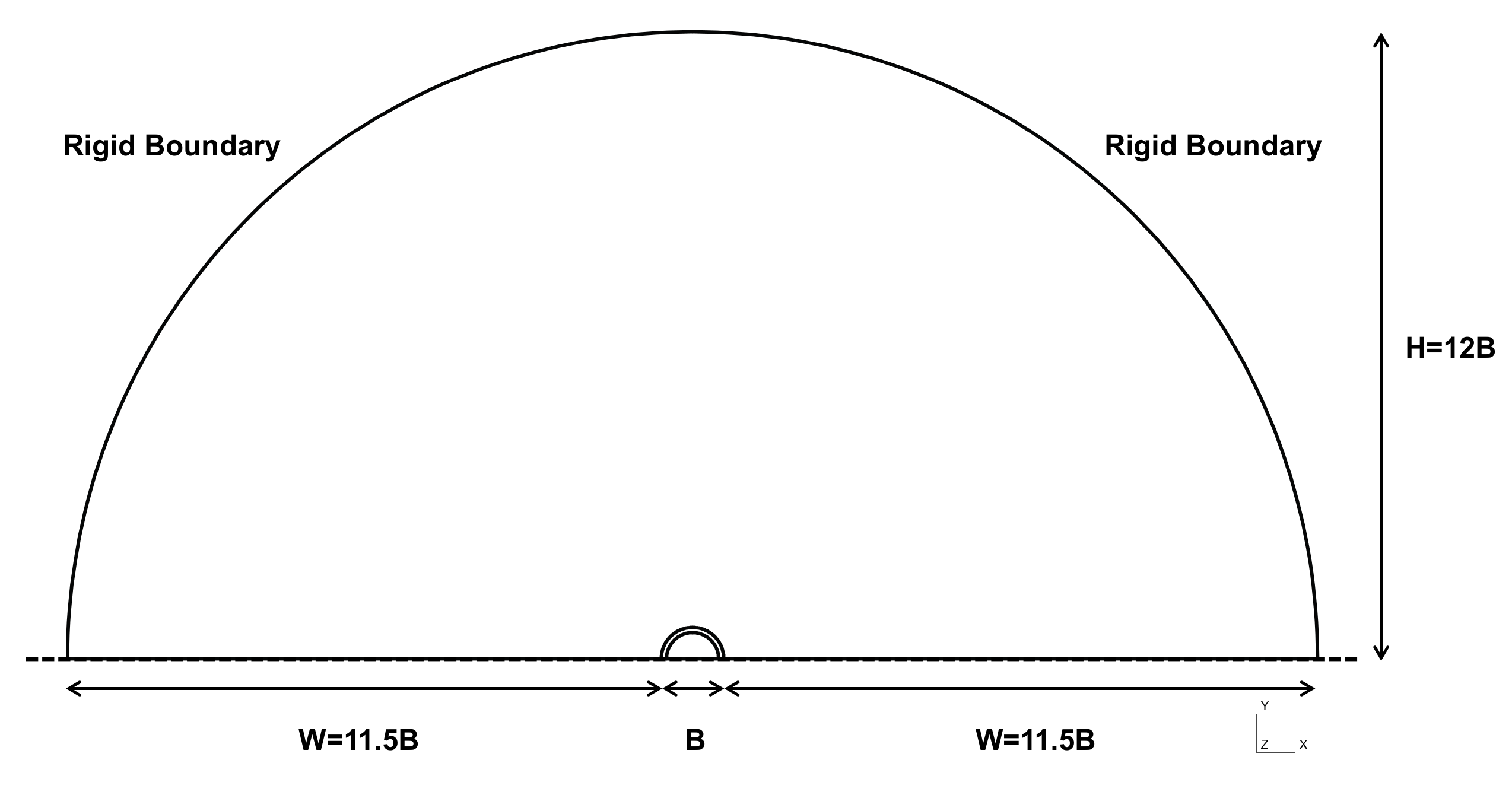
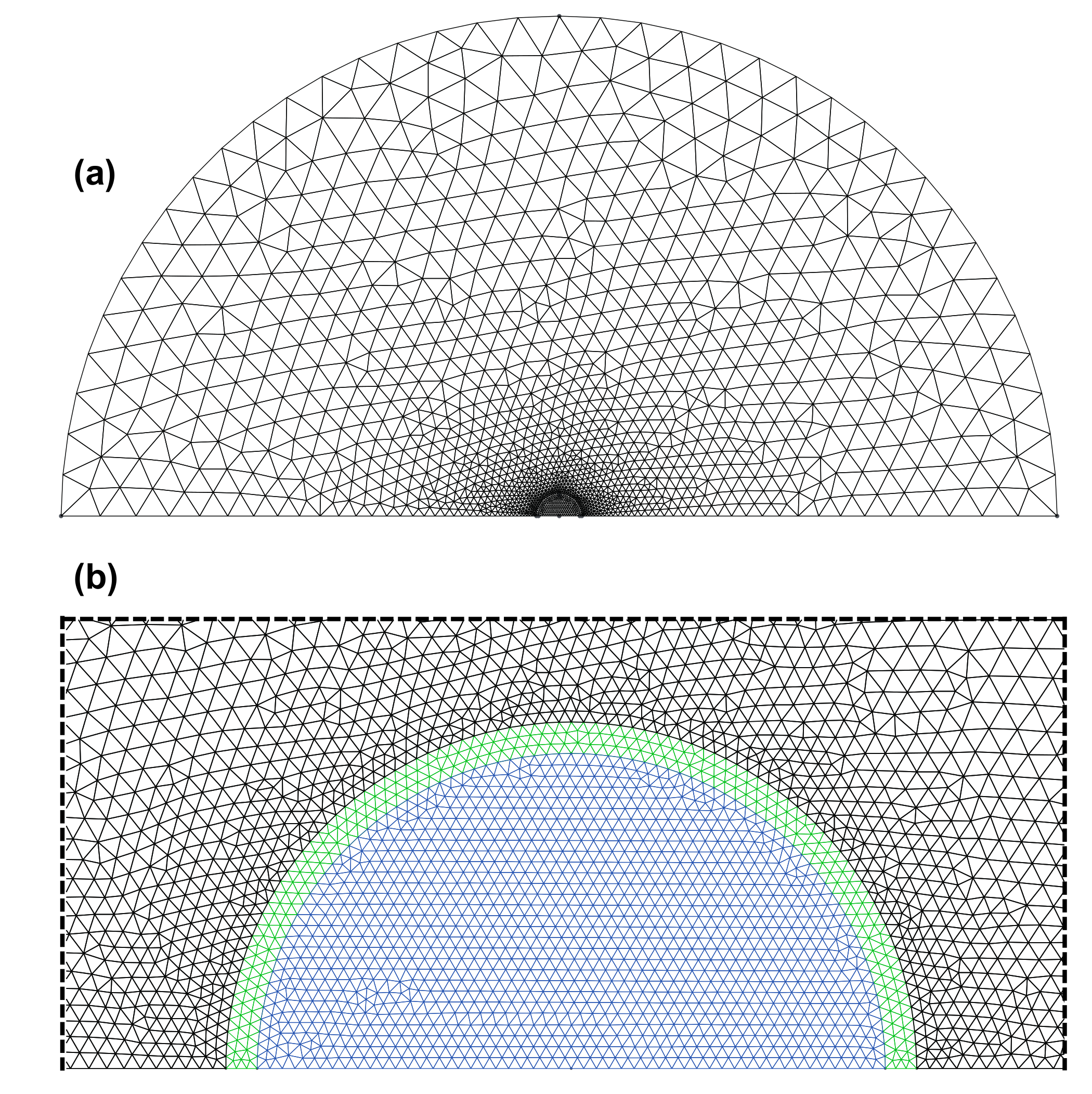

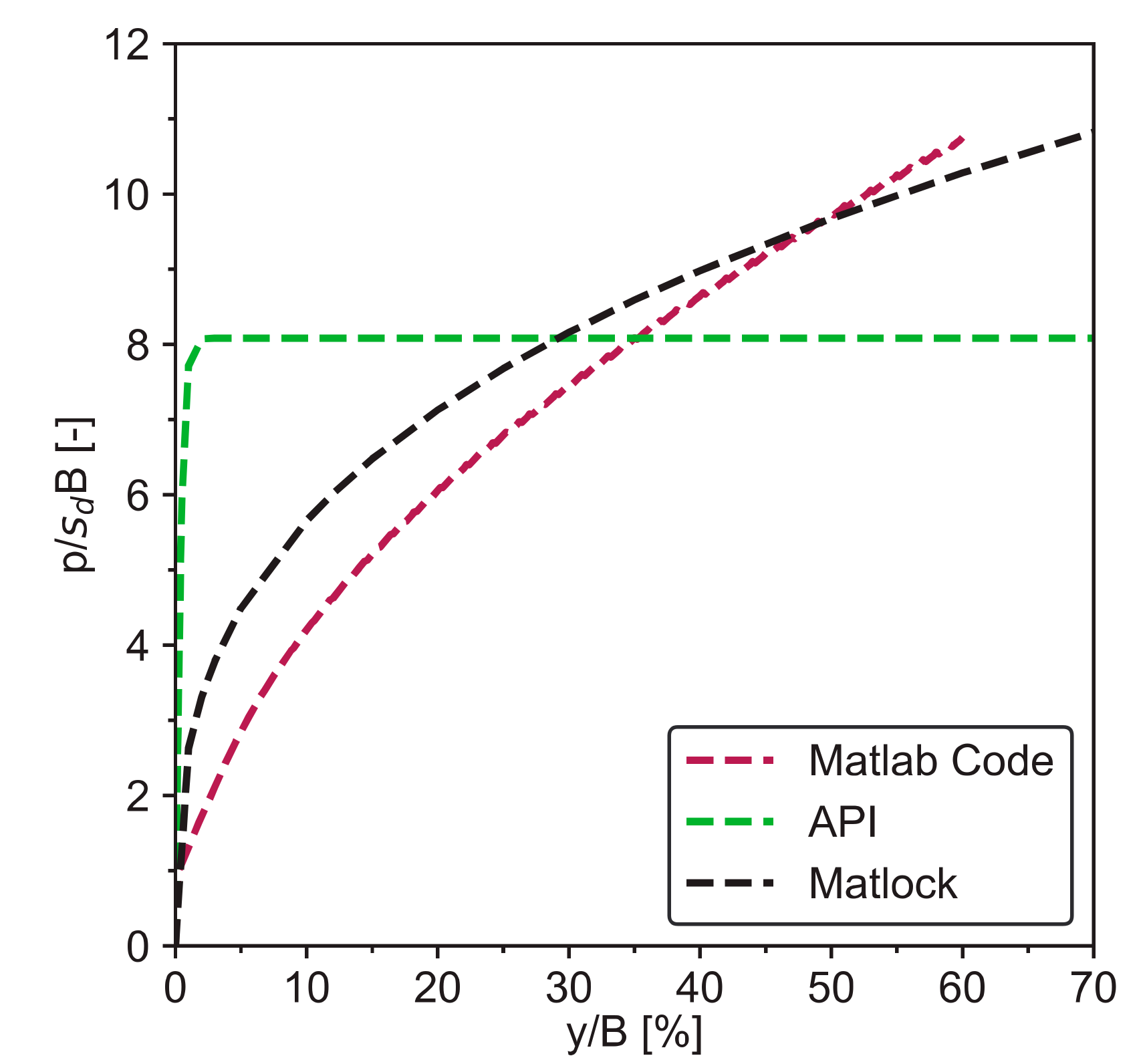
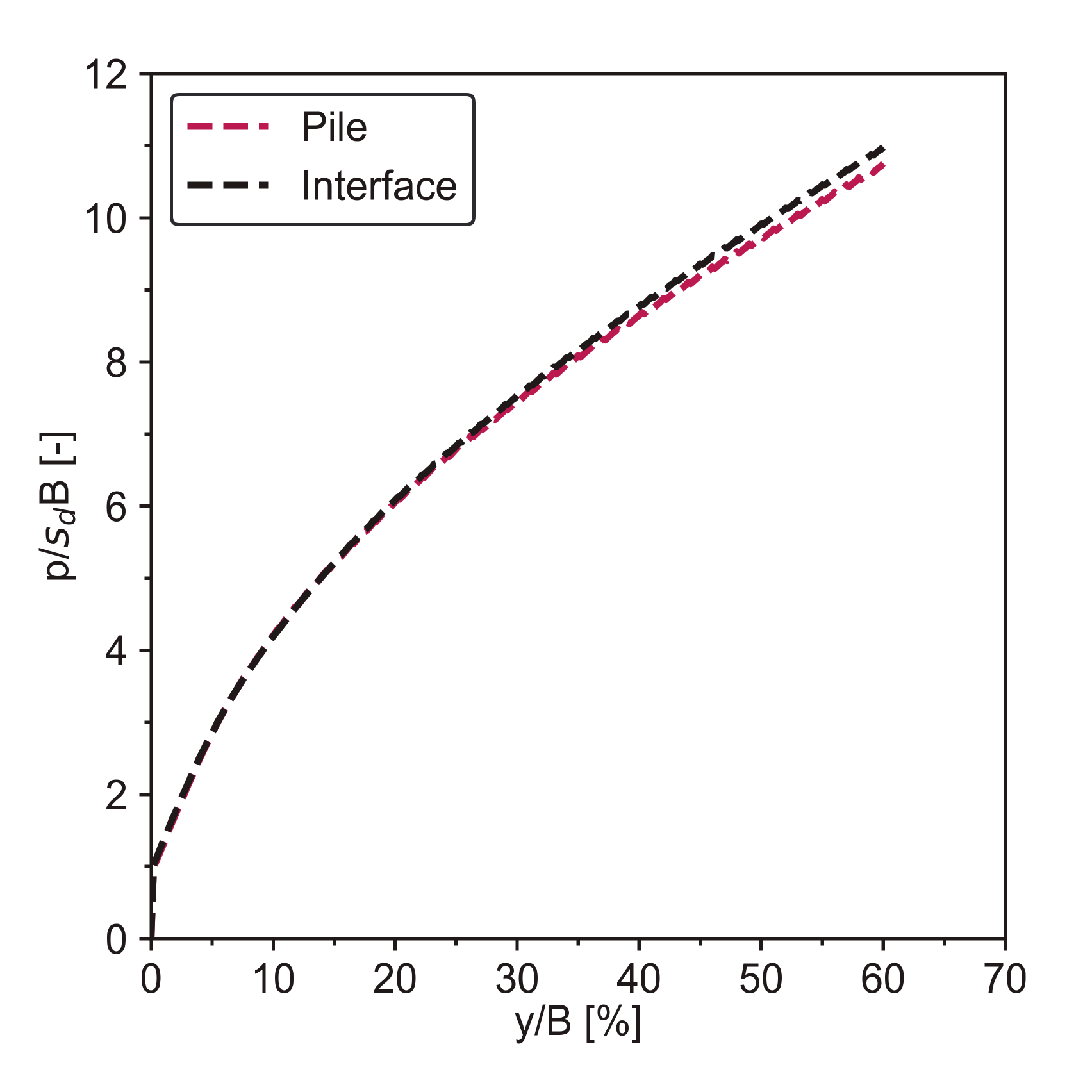
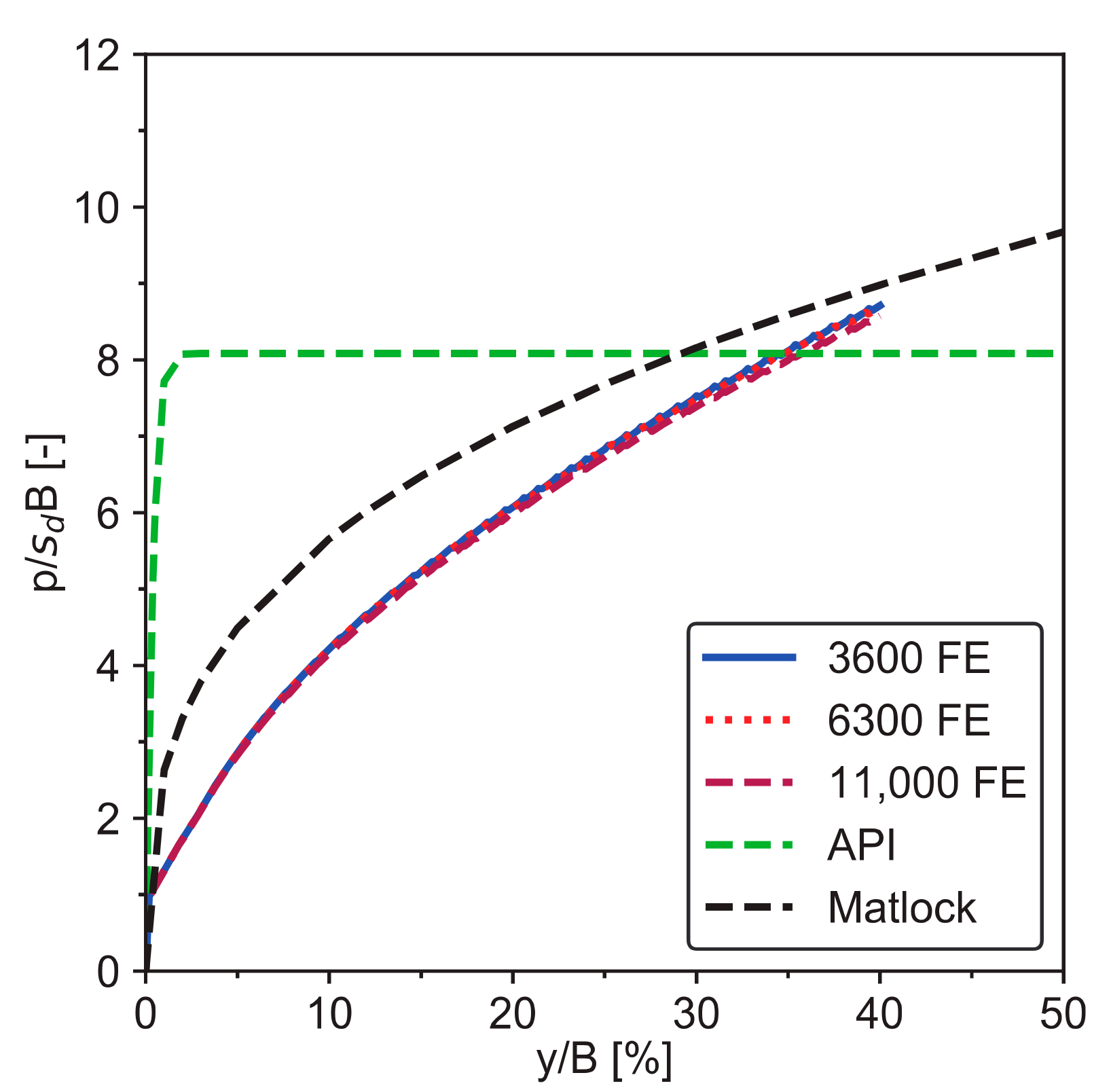


| γ (kN/m3) | z (m) | K0 (-) | σzz (kPa) | σxx (kPa) |
|---|---|---|---|---|
| 20 | 10 | 0.5 | 200 | 100 |
| - | Young’s Modulus E (kPa) | Poisson’s Ratio υ (-) | Cohesion c (kPa) | Friction Angle φ (°) |
|---|---|---|---|---|
| Interface | 6000 | 0.3 | 3.31 | 19.33 |
| Soil | 6000 | 0.3 | 10 | 21.81 |
| Pile | 33 × 106 | 0.2 | - | - |
| Element Number (-) | Fitting Formulation | R2 |
|---|---|---|
| 3600 | 0.9524 | |
| 6300 | 0.9520 | |
| 11,000 | 0.9510 |
| Interface Thickness | Fitting Formulation | R2 |
|---|---|---|
| 5 mm | 0.9510 | |
| 7 mm | 0.9525 | |
| 1 cm | 0.9508 | |
| 2.5 cm | 0.9360 | |
| 5 cm | 0.9528 | |
| 10 cm | 0.9481 |
| Clay Fraction (%) | Young’s Modulus E (kPa) | Poisson’s Ratio υ (-) | Cohesion c (kPa) | Friction Angle δ (°) |
|---|---|---|---|---|
| 0 | 8000 | 0.3 | 0 | 26.40 |
| 27.5 | 7500 | 0.3 | 2.22 | 22.91 |
| 55 | 6000 | 0.3 | 3.31 | 19.33 |
| Clay Fraction (%) | Young’s Modulus E (kPa) | Poisson’s Ratio υ (-) | Cohesion c (kPa) | Friction Angle φ (°) |
|---|---|---|---|---|
| 0 | 8000 | 0.3 | 0 | 34.11 |
| 27.5 | 7500 | 0.3 | 2.22 | 25 |
| 55 | 6000 | 0.3 | 10 | 21.81 |
| Clay Content (%) | Fitting Formulation | R2 |
|---|---|---|
| 0 | 0.9839 | |
| 27.5 | 0.9668 | |
| 55 | 0.9510 |
Publisher’s Note: MDPI stays neutral with regard to jurisdictional claims in published maps and institutional affiliations. |
© 2021 by the authors. Licensee MDPI, Basel, Switzerland. This article is an open access article distributed under the terms and conditions of the Creative Commons Attribution (CC BY) license (https://creativecommons.org/licenses/by/4.0/).
Share and Cite
Yin, K.; Li, L.; Di Filippo, E. A Numerical Investigation to Determine the p–y Curves of Laterally Loaded Piles. Mathematics 2021, 9, 2783. https://doi.org/10.3390/math9212783
Yin K, Li L, Di Filippo E. A Numerical Investigation to Determine the p–y Curves of Laterally Loaded Piles. Mathematics. 2021; 9(21):2783. https://doi.org/10.3390/math9212783
Chicago/Turabian StyleYin, Kexin, Lianghui Li, and Eugenia Di Filippo. 2021. "A Numerical Investigation to Determine the p–y Curves of Laterally Loaded Piles" Mathematics 9, no. 21: 2783. https://doi.org/10.3390/math9212783
APA StyleYin, K., Li, L., & Di Filippo, E. (2021). A Numerical Investigation to Determine the p–y Curves of Laterally Loaded Piles. Mathematics, 9(21), 2783. https://doi.org/10.3390/math9212783






